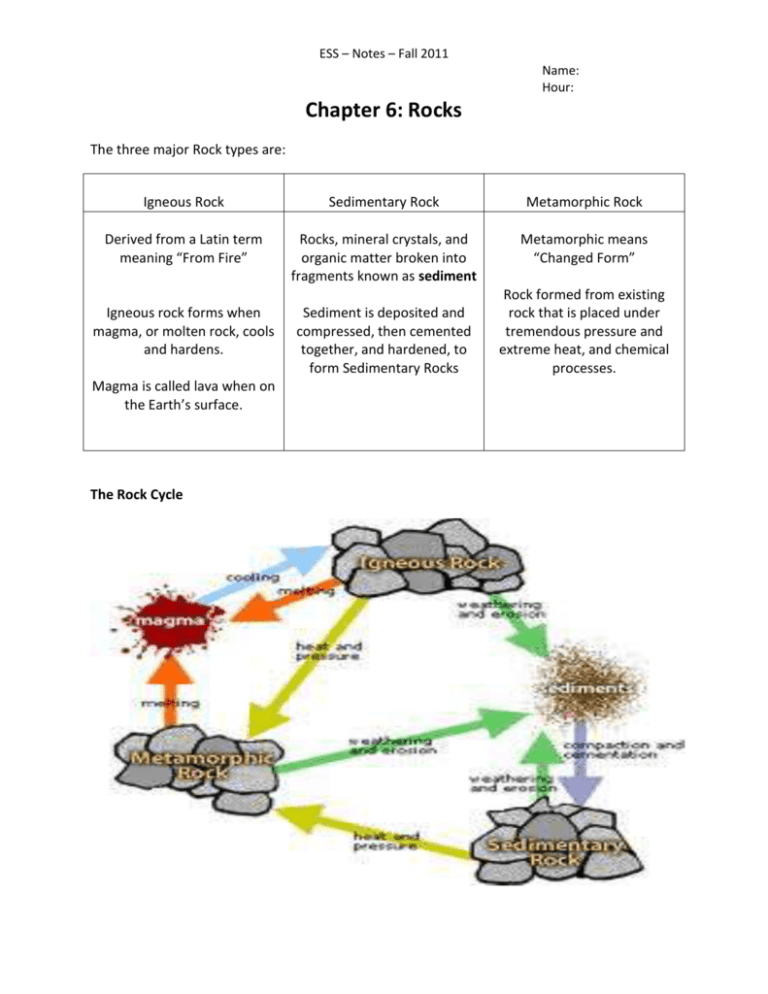Rocks - Images
advertisement

ESS – Notes – Fall 2011 Name: Hour: Chapter 6: Rocks The three major Rock types are: Igneous Rock Sedimentary Rock Metamorphic Rock Derived from a Latin term meaning “From Fire” Rocks, mineral crystals, and organic matter broken into fragments known as sediment Metamorphic means “Changed Form” Igneous rock forms when magma, or molten rock, cools and hardens. Magma is called lava when on the Earth’s surface. The Rock Cycle Sediment is deposited and compressed, then cemented together, and hardened, to form Sedimentary Rocks Rock formed from existing rock that is placed under tremendous pressure and extreme heat, and chemical processes. Answer the following questions using the diagram from the previous page. How does metamorphic rock turn into sedimentary rock? The metamorphic rock is weathered then goes through erosion forming sediment. The sediment it then compacted and cemented forming sedimentary rock. How does sedimentary rock turn into igneous rock? Sedimentary rock undergoes massive heat and pressure forming metamorphic rock then melts to form magma. When the magma cools it forms igneous rock. How does igneous rock turn into metamorphic rock? Igneous rock undergoes heat and pressure and the igneous rock is turned into metamorphic rock. How does sedimentary rock turn into a different sedimentary rock? Sedimentary rock undergoes weathering and erosion forming sediment. The sediment is then compacted and cemented forming a new sedimentary rock. Properties of Rocks ALL rocks have a distinct physical and chemical property that is determined by how the rock is formed. Igneous Rock Most igneous rock can be identified as crystalline, or made of crystals. The chemical composition of minerals in the rock and the rock’s texture determine the identity of the igneous rock. Magma: forms when rocks are put under extreme temperatures and pressures forming magma. Partial melting: When different minerals melt in igneous rocks leaving others unmelted. Textures of Igneous Rocks: Intrusive Extrusive Rock formed from SLOW cooling beneath Earth’s surface. Rock formed from FAST cooling on the Earth’s surface. COARSE GRAINED – The slow cooling allows ‘groups’ of minerals to clump together. FINE GRAINED – The fast cooling does not allow clumping of minerals. Ex. Granite Ex. Rhyolite Composition of Igneous Rocks: Felsic Rock Mafic Rock Light colored rock that forms because magma contains a large proportion of silica. Dark colored rock because of the iron based minerals. Contain a small portion of silica. Ex. Granite, rhyolite, and pumice. Ex. Basalt and gabbro Intrusive Igneous Rock Structures: Igneous rock masses that form underground are called intrusions because they force their way into, and in between, other rocks. This happens when magma intrudes , or enters, into other rock masses and then cools deep inside the Earth’s crust. **** Will always be younger than the rock around them**** Batholiths: Largest of all intrusions. Spread over at least 100km2 Batholiths = “deep rock” Stock: Like Batholiths but are less than 100km2 and at the surface of the crust. Laccoliths: Magma flows between rock layers and forms a dome. Laccolith = “lake of rock” Sills: Magma flows between rock layers and hardens. Like a window sill forms horizontally. Dikes: Magma forced through rock layers vertically.







